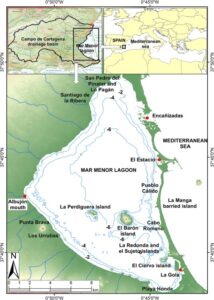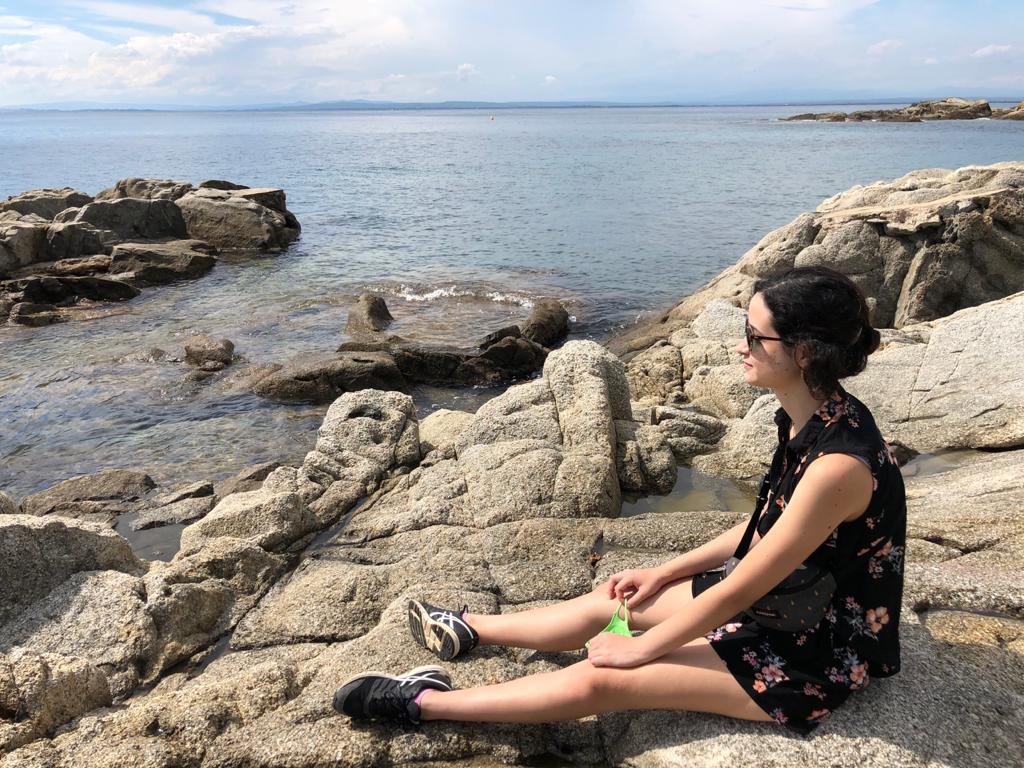Cortés-Melendreras, E., Gomariz-Castillo, F., Alonso-Sarría, F., Giménez Martín, F. J., Murcia, J., Canales-Cáceres, R., Ramos Esplá, A. A., Barberá, C., & Giménez-Casalduero, F. (2022). The relict population of Pinna nobilis in the Mar Menor is facing an uncertain future. Marine Pollution Bulletin, 185(November). https://doi.org/10.1016/j.marpolbul.2022.114376
A majestic shell in danger
The species that is our focus today is the Pinna nobilis (a type of pen shell), a filtering mollusc from the Mediterranean. It can grow to be pretty big, up to 120 cm, being one of the largest bivalves in the world! Its filtering contributes to keeping water clean in coastal areas where there are seagrass meadows or sandy bottoms, where it lives.
Sadly, there was a massive mortality event in 2016 which killed most of the specimens on the Spanish Mediterranean coast. This was attributed to a parasite, the Haplosporidium pinnae, although it’s possible other pathogens had a role as well. Because of that, it has been declared a critically endangered species on the International Union for Conservation of Nature Red List of Threatened Species.
However, there is a tiny hope, as although the pandemic spread to most of the Mediterranean, coastal lagoons became shelters where the species resisted the infection. This is quite important as these places not only protect the species, but they also act as sources of larvae for the rest of the sea to help recover other populations. Despite this, there was a high mortality event in these places as well in summer of 2016, but it seems like it wasn’t due to the parasite. This could be explained by an environmental collapse that has been going on since 2015 caused by too much nutrient input by agriculture, causing a rise in phytoplankton concentration and algae blooms. These stopped light from reaching the bottom and, consequently, vegetation started to die. Oxygen levels dropped and it affected our big mollusc too.
There have been other events, like extreme rainfall, that have ended up affecting them as well.
Directing our focus on…
The goal of this study is to check on the P. nobilis’ population in a lagoon called Mar Menor, see how they are distributed in the area and what factors influence that.
The Mar Menor is a 135 km2 coastal lagoon in the Southwestern Mediterranean sea, in Southeast Spain, as we can see in Figure 1. It has noteworthy characteristics such as high salinity, and high temperature with big seasonal/daily temperature changes, going from 8 to 32ºC. The mean depth is 3.5 m. It is the main receiver of a drainage basin, the Campo de Cartagena. The lagoon is separated by La Manga, a sandy bar, which is crossed by three shallow channels.

P. nobilis became a ley species after colonizing 65% of the surface, until 2014 and all the mortality events.
But how was it achieved? For the study, they used statistical models of species-environment relationships, based on their distribution and environmental predictors.
The localization was done thanks to different transects to be able to count and georeference them. A modified linear transect was used to survey the species in a 50 m length and 3 m wide line. Trained citizens also participated in complementary campaigns in depths of 0-3 m.
Dead or alive?
In campaigns between 2018 and 2019, some individuals were found, but they were uprooted or knocked down, probably because of fishing nets. In one of the islands studied, La Perdiguera, the entire colony had been removed probably by illegal fishing.
A total of 686 alive mussels were found in the transects. Some dead ones were also found, especially in depths below 3 m, where past that threshold, no alive mussel was observed. The dead pen shells were also the bigger ones, with a maximum size of 84.63 cm. The maximum size measured in alive ones was 58.48 cm.
The maximum presence probability is at some distance from the El Estacio Channel, and reaches its maximum at about 7000 m distance. This distance coincides with the populations of maximum density on El Barón Island. There are more populations found, and they are different from the patterns studied in 2017.
Missing mussels
The fact that bigger individuals can be found in deeper areas can be explained by the fact that the first colonization, in 1980, was from a large population, which suffered less anthropogenic pressures and also came from a much stabler place. After some years, this species was able to colonize the rest of the lagoon, even shallower places. However, because of anthropogenic activities such as extraction by tourists and fishermen, it ended up influencing the species’ reproductive rate.

The results show a patchy distribution; this behavior has been studied by other authors as a characteristic of this species. Comparing the distributions between 2021 and 2014, they are the complete opposite. In 2021, their distribution was limited to a depth range between 0.5 and 2.8 m, with 90% of them concentrated between 1 and 2 m, 450 m to the coast. The larger distance with specimens observed was more than 1000 m on the islands. In 2014, it was the other way around, with a lower presence probability near the coastline that increased the further away from it, stabilizing at 1000 m.
But how can that be explained? It is probably because of the low oxygen events (hypoxia) in 2015 and 2016. These kinds of events (called the eutrophication process) are what influence our mussels’ distribution, which caused the death of more than 90% of the population in 2014.
There have been more mortality events associated with the Haplosporidian infection, in 2017 and 2019, the latter probably caused by resistant forms of the parasite.
Right now, the population is estimated to not exceed 1500 specimens. The system is unstable with the eutrophication events, illegal fishing and others.
Measures taken
What could be done? Between January and September 2018, the conditions in the Mar Menor improved thanks to policies controlling agricultural discharges, plus some beneficial weather.
Other actions have been designed to maintain the viability of the pen shell population. Monitoring the current population, surveillance of the different events that could affect their areas and reproductive events with larval collectors, etc. The latter have been successful, which is a ray of hope between all the mortality events from the last few years.
Establishing protocols for maintenance and reproduction in captivity could only work if the actions taken directly in the lagoon don’t work. It is more crucial to stabilize the environmental conditions of the lagoon, something that hasn’t been reached yet.
To conclude this shell of a problem
This study observed the spatial distribution and its influencing factors of the pen shell Pinna nobilis between 2017 and 2020. Such information is key to understanding their survival hotspots and how they react to different environmental factors in places where the mussel survived the infection. Moreover, this study used a framework which turned out to be useful to characterize species’ spatial distribution for planning and management.
The future is uncertain for our big mussel, but the species will continue to be studied and efforts will be made to protect it. Hope is the last thing we lose!
Cover photo by Patricia Prado

I have a degree in Sea Science from the University of Barcelona, Spain. My main scientific interests are about conservation and ecology, especially anything about marine invertebrates. I find them the most fascinating creatures on Earth, strange yet so familiar. On a visit to the beach as a baby, I learned to crawl by going towards the sea at full speed! I enjoy reading, drawing, and writing fantasy novels in my spare time.

